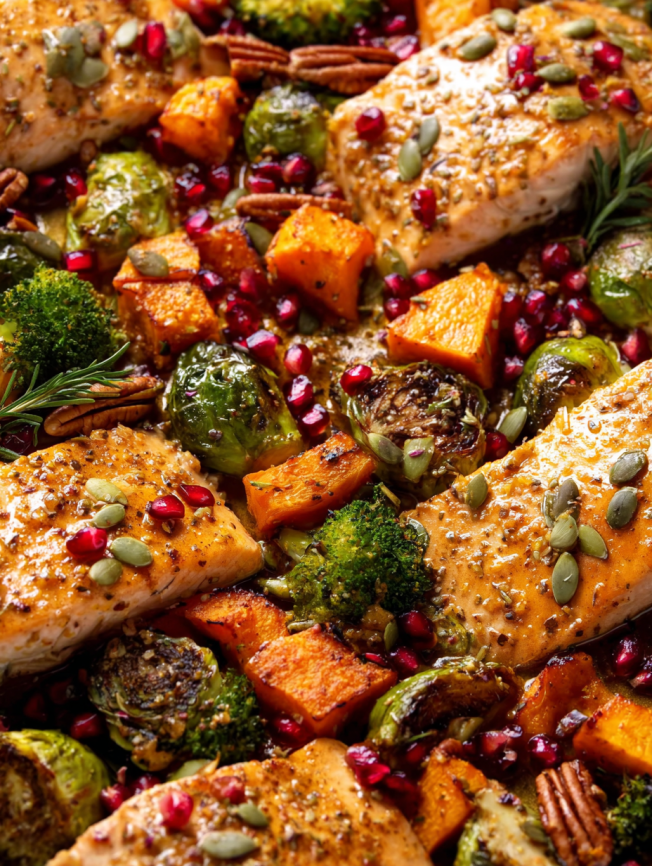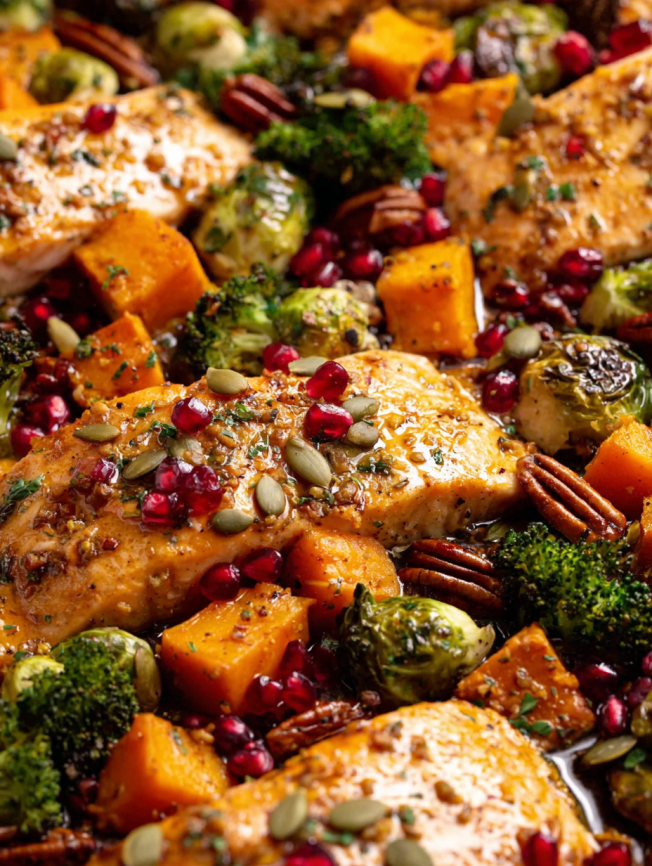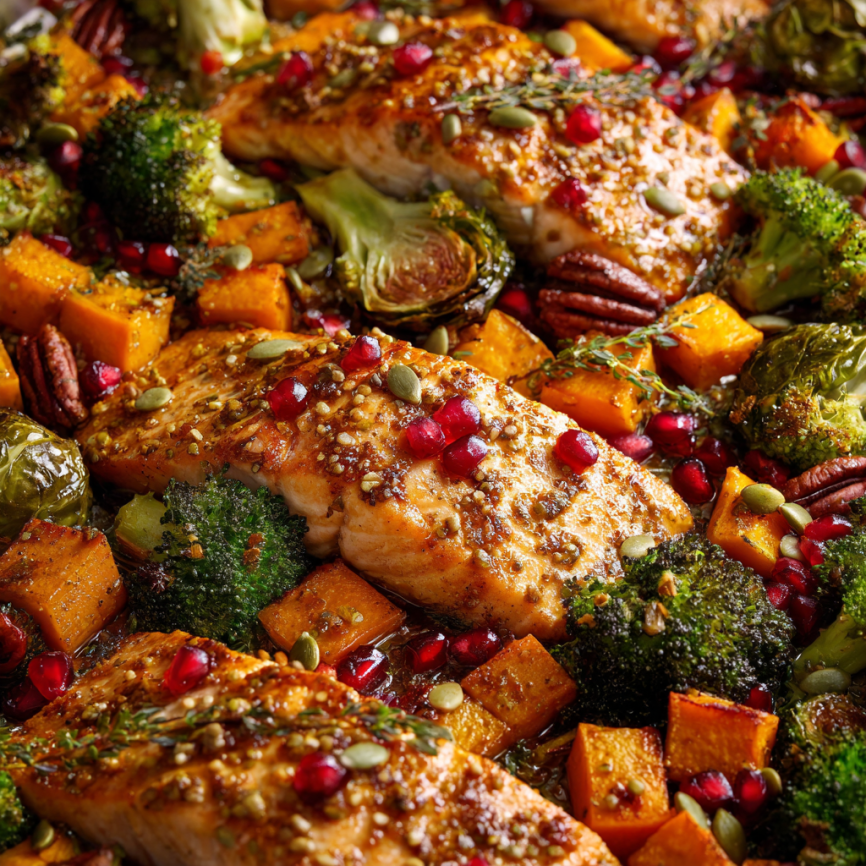Picture this: it’s 6 PM on a busy Wednesday, everyone’s hungry, and you need dinner on the table fast. As a parent who juggles work, kids’ activities, and household duties, I’ve learned that sheet pan dinners are absolute lifesavers. This Maple Mustard Salmon recipe has become my secret weapon for those nights when I want to serve something both nutritious and delicious without spending hours in the kitchen.
The first time I made this dish, I was skeptical that something so simple could taste so incredible. However, the magic happens when that sweet maple syrup meets the tangy Dijon mustard, creating a glaze that transforms ordinary salmon and vegetables into restaurant-quality fare. My teenagers, who usually grumble about eating vegetables, now actually request “that salmon with the crispy Brussels sprouts.” Even better, cleanup is a breeze since everything cooks on one pan.
Why This Sheet Pan Salmon Will Become Your Go-To Dinner
Effortless One-Pan Cooking
Sheet pan dinners represent the pinnacle of efficient cooking, and this recipe showcases exactly why. Everything cooks together in perfect harmony, with the vegetables getting a head start while the salmon joins the party later. Moreover, the cleanup couldn’t be simpler – just one pan to wash when dinner’s done.
Balanced Nutrition in Every Bite
This meal delivers complete nutrition without any guilt. The salmon provides heart-healthy omega-3 fatty acids and high-quality protein, while the Brussels sprouts and sweet potatoes contribute fiber, vitamins, and antioxidants. Additionally, the maple mustard glaze adds incredible flavor without relying on heavy sauces or excessive calories.
Customizable for Every Family
Picky eaters in your household? No problem! This recipe adapts beautifully to different preferences and dietary needs. You can easily swap vegetables, adjust the sweetness level, or modify portions to suit everyone at your table. Furthermore, the cooking method works with various fish types if salmon isn’t your family’s favorite.
Essential Ingredients for Success
The Star Players
- 1 lb. salmon fillets – Choose fresh, skin-on fillets for best results
- 10 oz. halved Brussels sprouts (about 4 cups) – Fresh is best, but frozen works too
- 1 medium/large sweet potato, peeled and ½” diced (about 4 cups) – Uniform sizing ensures even cooking
The Magical Glaze Components
- ⅓ cup olive oil – Creates the base and helps vegetables caramelize
- ⅓ cup maple syrup – Provides natural sweetness and beautiful caramelization
- 3 tablespoons Dijon mustard – Adds tangy depth that balances the sweetness
- ½ teaspoon garlic powder – Enhances overall flavor complexity
- Kosher salt and fresh cracked pepper – Essential for bringing out all flavors
Beautiful Finishing Touches
- Pecans – Add delightful crunch and nutty richness
- Pumpkin seeds – Provide texture and healthy fats
- Pomegranate seeds – Deliver pops of color and tart sweetness
Step-by-Step Cooking Instructions
Preparation and Setup
Start by preheating your oven to 425 degrees Fahrenheit. This high temperature is crucial for achieving caramelized vegetables and properly cooked salmon. While the oven heats, gather all your ingredients and prepare a rimmed sheet pan.
Next, create the star of this dish – the maple mustard glaze. In a measuring cup, whisk together the olive oil, maple syrup, Dijon mustard, and garlic powder. Season generously with kosher salt and freshly cracked pepper. This glaze will be divided between the vegetables and salmon, so make sure it’s well combined.
Vegetable Foundation
Arrange the halved Brussels sprouts and diced sweet potato on your rimmed sheet pan. The key to success here is ensuring the pieces are roughly uniform in size – this guarantees even cooking. Brussels sprouts should be halved lengthwise, while sweet potatoes need ½-inch cubes.
Pour half of the maple mustard glaze over the vegetables, then toss thoroughly to ensure every piece is coated. Spread the vegetables in a single layer, avoiding overcrowding. Overcrowded vegetables will steam rather than roast, preventing that desirable caramelization.
The First Roasting Phase
Place the pan in the preheated oven and roast for 15 minutes. During this time, the vegetables will begin to soften and develop those beautiful caramelized edges. The sweet potatoes will start to become tender, while the Brussels sprouts will begin their transformation from bitter to sweet.
Adding the Salmon
After 15 minutes, carefully remove the pan from the oven. Now it’s time to add the salmon fillets, nestling them between the partially cooked vegetables. Pour the remaining maple mustard glaze over the salmon, using a spoon or brush to spread it evenly across each fillet.
Return the pan to the oven for another 10-12 minutes. The salmon is done when it flakes easily with a fork and reaches an internal temperature of 145°F. Be careful not to overcook, as salmon can quickly become dry.
Final Crisping Touch
For the perfect finish, turn on your broiler and give everything 1-2 minutes under the high heat. This final step creates irresistibly crispy edges on the vegetables and a beautiful glaze on the salmon. Watch carefully during broiling to prevent burning.

Serving Suggestions and Presentation
Plating for Maximum Appeal
Transfer the roasted salmon and vegetables to a large serving platter or individual plates. The colorful combination of golden sweet potatoes, emerald Brussels sprouts, and pink salmon creates a visually stunning presentation that’s Instagram-worthy.
Sprinkle the pecans, pumpkin seeds, and pomegranate seeds over the entire dish just before serving. These garnishes not only add textural contrast but also provide bursts of complementary flavors that elevate the entire meal.
Perfect Accompaniments
While this sheet pan dinner is complete on its own, consider serving it alongside some fluffy quinoa or wild rice to make it even more filling. A simple green salad with lemon vinaigrette provides a fresh, light contrast to the rich, glazed main course.
Creative Variations and Substitutions
Vegetable Alternatives
The beauty of sheet pan cooking lies in its flexibility. Maintain the 8-cup ratio of chopped vegetables, but feel free to substitute based on your family’s preferences or what’s available in your refrigerator. Broccoli florets, cauliflower, carrots, or butternut squash all work wonderfully.
Consider seasonal variations too. In spring, try asparagus and baby potatoes. Summer calls for zucchini and bell peppers, while fall welcomes acorn squash and parsnips. Each combination brings its own unique flavor profile to the dish.
Protein Swaps
While salmon is spectacular in this recipe, other fish varieties work equally well. Try it with Arctic char, trout, or even firm white fish like cod or halibut. For non-fish options, chicken thighs or pork tenderloin adapt beautifully to this cooking method, though cooking times may need adjustment.
Glaze Modifications
The maple mustard glaze can be customized to suit different taste preferences. For a spicier version, add a teaspoon of whole grain mustard or a pinch of cayenne pepper. Those preferring less sweetness can reduce the maple syrup and add an extra tablespoon of Dijon mustard instead.
Make-Ahead Strategies and Meal Prep
Preparation Shortcuts
This recipe lends itself beautifully to meal prep strategies. Wash and chop the vegetables up to two days in advance, storing them in the refrigerator in separate containers. The maple mustard glaze can also be whisked together and refrigerated for up to a week.
For even quicker weeknight assembly, portion the vegetables and glaze into individual containers on Sunday. During the week, simply dump everything onto the sheet pan and follow the cooking instructions.
Leftover Magic
Leftovers transform beautifully into new meals throughout the week. Flake the leftover salmon over mixed greens for an elegant salad, or incorporate everything into grain bowls with quinoa or brown rice. The roasted vegetables also make excellent additions to morning omelets or breakfast hash.
Pro Tips for Perfect Results
Choosing the Right Salmon
Select salmon fillets that are similar in thickness to ensure even cooking. Skin-on fillets work best because the skin helps retain moisture and prevents the fish from drying out. Don’t worry if you’re not a fan of eating salmon skin – it removes easily after cooking and serves its protective purpose during the roasting process.
Sheet Pan Selection
Use a large, rimmed sheet pan (also called a half-sheet pan) for best results. The raised edges prevent the glaze from dripping into your oven, while the large surface area ensures everything has room to roast properly rather than steam.
Temperature and Timing Guidelines
Every oven runs slightly differently, so use visual cues along with timing. The vegetables should be tender and lightly caramelized, while the salmon should flake easily and appear opaque throughout. If your vegetables need more time but the salmon is done, remove the salmon and continue roasting the vegetables as needed.

Frequently Asked Questions
Can I use frozen vegetables for this recipe?
Fresh vegetables deliver the best results, but frozen can work in a pinch. Thaw and pat dry frozen Brussels sprouts and sweet potato cubes before using. Keep in mind that frozen vegetables may release more moisture during cooking, potentially affecting the final texture.
What if I don’t have Dijon mustard?
Regular yellow mustard can substitute for Dijon, though the flavor will be milder and less complex. Whole grain mustard also works beautifully and adds interesting texture to the glaze. For a more sophisticated flavor, try using grainy French mustard.
How do I know when the salmon is perfectly cooked?
Properly cooked salmon will be opaque throughout and flake easily when tested with a fork. The internal temperature should reach 145°F when measured at the thickest part. Avoid overcooking, as salmon continues cooking slightly even after removal from the oven.
Can this recipe be doubled for larger families?
Absolutely! Use two sheet pans to avoid overcrowding, which would cause steaming instead of roasting. You may need to rotate the pans halfway through cooking to ensure even browning. The glaze recipe doubles perfectly as well.
What’s the best way to reheat leftovers?
Gentle reheating works best to maintain the salmon’s texture. Use a 350°F oven for 8-10 minutes, or reheat individual portions in the microwave at 50% power in 30-second intervals until warmed through. Avoid high heat, which can make the salmon tough.
Can I make this dairy-free or gluten-free?
This recipe is naturally both dairy-free and gluten-free! Just double-check that your Dijon mustard doesn’t contain any gluten-containing ingredients, though most brands are naturally gluten-free.
Recipe Summary:
- Prep Time: 10 minutes
- Cook Time: 30 minutes
- Total Time: 40 minutes
- Servings: 4
- Difficulty: Easy
- Method: Sheet Pan Roasting
Nutrition per serving:
- Calories: 306
- Protein: 19.6g
- Carbohydrates: 21.3g
- Fat: 17.2g
- Fiber: 2.8g
- Sugar: 12.7g

